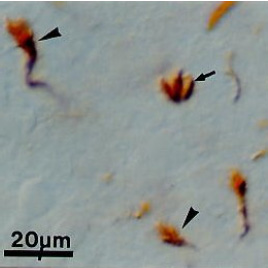Axonal Growth Cones Mouse Monoclonal Antibody [Clone ID: 2G13]
Specifications
| Product Data | |
| Clone Name | 2G13 |
| Applications | IHC, WB |
| Recommended Dilution | Immunohistochemistry on Frozen Sections. Immunohistochemistry on Paraffin Sections. Protein digestion pretreatment of paraffin sections not required. Antigen retrieval using heat treatment prior to staining of paraffin sections not required. Clone 2G13 has also been reported to work in Western Blotting. |
| Reactivities | Chicken, Mouse, Rat |
| Host | Mouse |
| Isotype | IgM |
| Clonality | Monoclonal |
| Immunogen | Embryonic chick tectal membranes. Spleen cells from immunised mice were fused with cells of the mouse NS1 myeloma cell line. |
| Specificity | This antibody recognizes intracellular 2G13P which is localized to Growth Cones, particularly filopodia and lamellipodies in developing Rat CNS and embryonic neurons in culture. Studies suggest that 2G13P interacts with the filamentous actin cytoskeleton and therefore may be involved in Growth Cone motility (Stettler et al. 1999). Mouse anti Growth Cone antibody, Clone 2G13 has been used for the detection of growth cones by immunohistochemistry and identification of 40S ribosomal protein SA by Western blotting in Chicken and Rat samples (Baloui et al. 2004). |
| Formulation | State: Supernatant State: Liquid Tissue Culture Supernatant Preservative: 0.09% Sodium Azide |
| Background | Subsequent investigation has identified this protein to be 40S ribosomal protein SA, also known as 37 kDa laminin receptor precursor or Laminin receptor 1 (Baloui et al. 2004). 40S ribosomal protein SA is a 296 amino acid ~37kDa membrane, cytoplasmic and nuclear protein required for the assembly and/or stability of the 40S ribosomal subunit. In vertebrate evolution the molecule has acquired a secondary function as a laminin receptor (UniProt: P50890). In growth cones expression is notable particularly in filopodia and lamellipodia in developing rat CNS and embryonic neurons in culture (Stettler et al. 1999). 40S ribosomal protein SA interacts with the filamentous actin cytoskeleton and therefore may be involved in growth cone motility (Stettler et al. 1999). |
| Synonyms | Growth Cone Marker |
| Reference Data | |
Documents
| Product Manuals |
| FAQs |
| SDS |
{0} Product Review(s)
0 Product Review(s)
Submit review
Be the first one to submit a review
Product Citations
*Delivery time may vary from web posted schedule. Occasional delays may occur due to unforeseen
complexities in the preparation of your product. International customers may expect an additional 1-2 weeks
in shipping.






























































































































































































































































 Germany
Germany
 Japan
Japan
 United Kingdom
United Kingdom
 China
China



